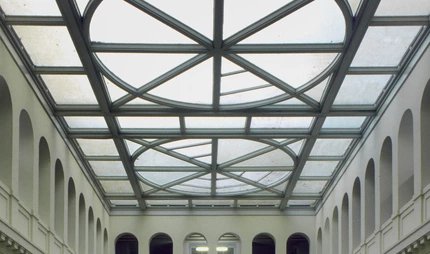
Umlauftank 2 (circulation tank)
Rosy prospects
What’s pink, blue and enormous? Berlin’s garish “pink tube” – the Umlauftank 2 on Schleuseninsel (sluice island) at the edge of the Tiergarten.
In the opinion of architect Hans-Günter Merz, the Umlauftank 2, or UT2 for short, whose refurbishment he took charge of from 2014 to 2017, is “a cheeky structure”. As a research facility of the Technical University of Berlin it is used for flow measurement. The predecessor institute, the Versuchsanstalt für Wasserbau und Schiffbau (research institute for hydraulic engineering and shipbuilding), previously conducted tests here during the era of the German Empire. In 1967, the architect Ludwig Leo designed the new Umlauftank 2, which went into operation in 1974.
But the UT2 is more than just a research facility: Leo designed the “pink tube” as a counterpoint to the megalomaniac architecture of the National Socialists.
In the 1930s, the architect and general building inspector of the imperial capital, Albert Speer, widened today’s Straße des 17. Juni. It played an important role in the plans for the “global capital Germania”. In the 1970s, Ludwig Leo incorporated his enormous bright pink tube within the field of vision of this Nazi urban planning – and sent a clear signal.
Real eye-catcher
In the construction of the circulation tank, the architect focused primarily on the technical requirements. The colours reveals the function to the observer. The “pink tube” forms the water circuit. Inside, a turbine sets water masses in motion, generating a flow velocity of up to ten metres per second. Here, researchers test ships and ship models in real conditions. The vessels that fit into the 120-metre tube can be up to nine metres long.
This leads through a five-storey building clad in blue aluminium panels. It houses the laboratory hall, test benches and offices.

Der Umlauftank 2 von Ludwig Leo gehört zur ehemaligen Versuchsanstalt für Wasserbau und Schiffbau der Technischen Universität Berlin und liegt an prominenter und weithin sichtbarer Stelle auf der Schleuseninsel am Rande der Straße des 17. Juni.
Renovated gem
The Umlauftank 2 is the largest in the world; international researchers and engineers travel to Berlin to use it for their experiments. And not only in the field of nautical science. Scientists have also studied the movement of penguins here.
For a long time, the Umlauftank 2 rusted away. The pink shell, made of polyurethane foam, did not age well. From 2014 to 2017, the Wüstenrot Foundation financed the restoration of the monument. Since then, Berlin’s idiosyncratic industrial monument has shone again in its pink and blue splendour.
Our tips for nearby the Umlauftank 2
In the vicinity of the Umlauftank 2 there are further Berlin Modernist sites to discover. For example the Kaiser Wilhelm Memorial Church at Breitscheidplatz. Or take the 100 bus (direction Alexanderplatz) to the Lützowplatz stop. On the other side of the Landwehrkanal you will find the Bauhaus-Archiv with the Museum für Gestaltung (Museum of Design) (currently closed for renovation).
Practical information from visitBerlin
The Umlauftank can be reached from the Zoologischer Garten station. To explore the city, we recommend the Berlin WelcomeCard for public transport.



